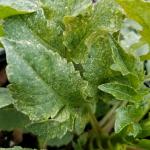This week two-spotted spider mites (Tetranychus urticae) were observed on Dahlia. Two spotted spider mites are a major pest of many greenhouse crops. They feed primarily on the leaf undersides of a wide range of ornamental and vegetable crops, piercing the cells with their stylet-like mouthparts to suck out the contents. The feeding injury results in a faint chlorosis or stippling on upper leaf surfaces. The destruction of cells results in reduced photosynthesis, and as damage increases, whole leaves turn yellow and may cause leaf drop and death of the plant. In severe infestations, the plants may be covered with webbing.
Look on the underside of the leaves for the mites and their eggs. Two-spotted spider mites are small and have eight legs. They are more closely related to spiders and ticks than insects. Adult females are about 0.5mm long and have an oval body that is rounded at the rear end. Males are slightly smaller with a body that is narrower and more pointed at the rear end. The color of spider mites can vary from orange, light yellow, yellow-brown to dark-green with two dark spots on both sides of the body. A hand lens is needed to see them.
Spider mites lay more eggs and develop faster at high temperatures and lower humidity. Development starts around 54° F, increases with temperature and starts to decline after 86° F and stops at 104° F. Spider mites can be a problem during dry and hot weather conditions. When plants are heavily infested mites fall to the ground and walk to other plants. They can move from one leaf to another if plants are touching each other and also use the silk threads on their webs to move to other leaves or plants. They can also be moved by air currents in the greenhouse.
To prevent two-spotted spider mites, avoid over fertilizing plants. Increased fertility levels encourage lush, succulent growth which is ideal for two spider mites. Water-stressed plants are also more susceptible. Eliminate weeds in and around greenhouses that can harbor spider mites and increase relative humidity in the plant canopy.
Biological management: The most effective biological control agent for two-spotted spider mites is the predatory mite Phytoseiulus persimilis. P persimilis feeds only on two-spotted spider mites and feeds on all developmental stages, but has preference for eggs. Phytoseiulus persimilis develops faster than two-spotted spider mites when temperatures are not too high. At 68° F the average generation time of P. persimilis is shorter than that of the two-spotted spider mites. Under dry, warmer conditions P. persimilis has difficulty keeping up. The predatory mite Neoseiulus (Amblyseius) californicus is more tolerant of higher temperatures and lower humidity. Large concentrations of two-spotted spider mites (hotspots) can be controlled using the gall midge, Feltiella acarisuga. The larvae of Feltiella feed on all stages of two-spotted spider mites
Chemical management: For chemical management, contact or translaminar miticides can be used. Translaminar miticides are more effective because they penetrate leaf tissues and form a reservoir of active ingredient within the leaf which provides extended residual activity. Treatments require good coverage to leaf undersides and may need repeat applications during warm weather. Miticides with translaminar activity include abamectin (Avid, Lucid, Minx2), abamectin & bifenazate (Sirocco), chlorfenapyr (Pylon), and spiromesifen (Savate). Contact miticides include fenpyroximate (Akari), bifenazate (Floramite SC, Actaute SC), hexythiazox (Hexygon, Hexcel 50 DF), Clofentazine (Ovation), pyridaben (Sanmite).
Do not use Savate on New Guinea impatiens or geranium. Always read pesticide labels for plant safety information and make sure to follow all label recommendations and restrictions.
Make sure to rotate across different modes of action (MOAs) to prevent resistance development in the pest population.
For more information on managing two-spotted spider mites, refer to the New England Greenhouse Floriculture Guide:
https://greenhouseguide.cahnr.uconn.edu/sectionB.php#insects
- Geoffrey Njue, Extension Specialist, UMass Extension Greenhouse Crops and Floriculture Program with Jim Mussoni, Private IPM Scout
